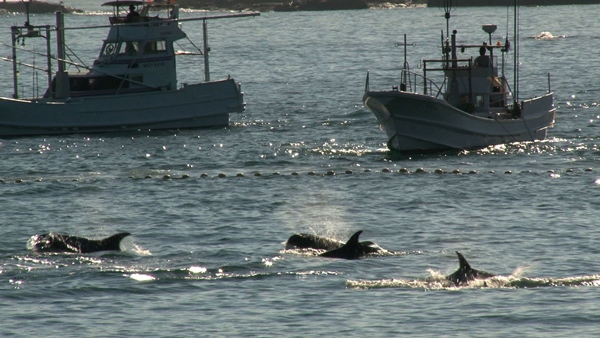This thought-provoking documentary centers on Taiji, a town in Japan where whale and dolphin hunting has been an integral part of life for approximately 400 years. For an annual festival, children and adults alike pay tribute to the sea animals—more than one child wears a bulbous whale costume, while the grown-ups put on traditional dress and eat dishes made with whale meat. These early, upbeat scenes give way to ones set on fishing vessels as crews venture forth in pursuit of pods of dolphins, which they will herd via the traditional method of drive hunting, involving nets thrown in the water.
As it turns out, a small group of environmentalists is camped nearby, recording everything the fishermen have been doing. They have a very different view of dolphins, which they consider a highly intelligent creature, while the citizens of Taiji view them as another fish. The town’s festival will culminate in the captured dolphins either being killed or sold to the entertainment industry, which the activists decry as loudly and angrily as possible. For their part, the locals tolerate these self-described “folk guardians” of nature and repeatedly defend the ritual hunt and its aftermath as their tradition.
Director Megumi Sasaki observes but does not pass judgment on the happenings in Taiji, which many moviegoers first learned about almost a decade ago via Louie Psihoyos’s The Cove (2009), the Academy Award–winning documentary that depicted the festival as the town’s dark secret and the townspeople as hostile toward outsiders. The film has received criticism for its negative depiction of Japanese people, and A Whale of a Tale, which is initially set in 2010, seems like a follow-up response. As the tension ramps up between the activists and locals, Sasaki interviews people on both sides, and in doing so, she gets at the heart of the issues underlying the friction, namely an unwillingness to see the other’s point of view.
The film is full of scenes like the one in which Taiji residents and Western visitors—the vast majority of whom is Americans, by the sounds of it—talk at the other without bothering to listen in return. Everyone has already drawn their proverbial line in the sand regarding the issue and will not budge. At one point, one of the central environmentalists makes an offer to purchase the captured dolphins from the fishermen. The latter cannot sell them for bureaucratic reasons, but their explanation is in Japanese, which the activists do not understand. But they’re not so much interested in the details of the refusal. As one of them puts it, all that matters is the “No.”
Overall, the film’s sympathies lean a little more toward the townspeople, who are wary of interacting with visitors after their experiences with the crew of The Cove. Not that the Westerners do much to dissuade the view that their goal is antagonizing; they talk a considerable amount of trash at the fishermen in hopes of getting a rise out of them that they can record and broadcast. Rather than spend too much time with the provocateurs, Sasaki pursues a much-needed history lesson regarding Taiji and its whaling culture, including its surprising connections to the United States. We also meet a local political group that represents the first hint that not everyone in the town unequivocally supports the practice; they offer to help set up a meeting between the activists and local government.
Unfortunately, the supposed dialogue between the two sides only reveals how truly entrenched they both are. However, the event spurs an American journalist, Jay Alabaster, to move to Taiji and get to know its people and whaling industry. He proves invaluable, providing pointed observations of the two sides as an increasing number of activists start coming to the town to protest. Of the environmentalists, he respects their willingness to sacrifice for their cause but takes them to task, since the fishermen take steps to conserve the species they’re hunting, which is not currently considered endangered. However, the film sidesteps the argument that dolphins are intelligent and therefore should not be hunted with the counterargument that the activists are attempting to anthropomorphize a non-human species.
Meanwhile, Alabaster tries to educate the locals on how the activists are winning the battle of public perception by revealing how incredibly un-media savvy the town is. He also interviews Japanese anti-whaling activists, who claim that the practice has already been on the decline as fewer people are buying whale meat than in the past. According to them, what has actually kept it from disappearing are the attacks by the West, which have led to increased support for whaling based largely on nationalistic sentiment. These activists, who oppose whaling because they doubt that the industry is transparent enough to prove its claims of sustainability, say it is now very difficult to express opposition because of accusations of siding against their own country. Listening to them, it’s clear the issue is not just one of East versus West but a debate within Japan itself.
The film acknowledges but does not focus on the actual killing of dolphins, which makes for a very different experience than The Cove, though we do see blood flowing in water. Activists claim that the fisherman shield off the process from watchful eyes because they have something to hide, while the latter claim it is no different than the American meat industry, which does not show the executions of animals to the public. So the arguments go back-and-forth and over and over, potentially overshadowing something equally important: how anti-whaling activism around the world and market forces have taken their toll on demand, portending an uncertain future for Taiji.
Though a bit talky at times, A Whale of a Tale proves a compelling and ultimately humane portrait of a people who, ironically, had previously been portrayed as inhumane. It also exposes how an issue can be far more complicated than it may at first seem.

















Leave A Comment